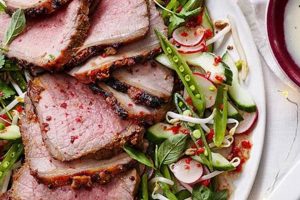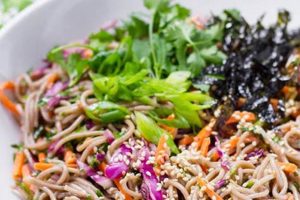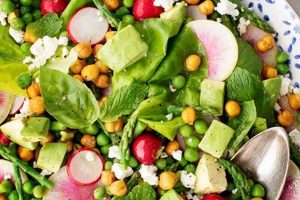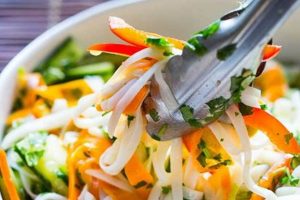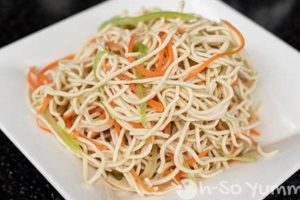This traditional Persian dish, a variation of Olivier salad, combines cooked potatoes, carrots, peas, pickles, chicken or other protein, and hard-boiled eggs in a mayonnaise-based dressing. Variations may include apples, raisins, or other fruits and vegetables, adding a distinct sweetness and textural complexity. It’s a staple at Persian celebrations and gatherings, often presented as a centerpiece due to its vibrant colors and artful presentation.
Its cultural significance stems from its adaptability and festive nature. Introduced to Iran in the 20th century, the dish has evolved, incorporating local flavors and ingredients, reflecting the Iranian culinary landscape. The ability to personalize ingredient ratios and additions makes it suitable for diverse palates and dietary preferences. It’s not merely a side dish but often serves as a substantial meal, especially during celebratory occasions. Its popularity has spread beyond Iran, introducing Persian culinary traditions to a wider audience.
Further exploration will delve into regional variations, specific ingredient preparations, and tips for achieving optimal flavor and texture. This examination provides a deeper understanding of this beloved dish, highlighting its evolution and enduring appeal.
Tips for Preparing an Authentic Olivier Salad
Achieving the perfect balance of flavors and textures in this classic dish requires attention to detail. The following tips offer guidance for preparing an authentic and delicious Olivier salad.
Tip 1: Ingredient Quality is Paramount: Selecting fresh, high-quality ingredients significantly impacts the final result. Opt for firm potatoes and carrots, crisp pickles, and fresh herbs.
Tip 2: Precise Vegetable Dicing: Uniformly dicing the vegetables ensures even cooking and a pleasing presentation. Aim for small, consistent pieces.
Tip 3: Proper Potato and Carrot Cooking: Overcooked vegetables result in a mushy texture. Cook until tender but still firm, then drain thoroughly to prevent excess moisture.
Tip 4: Chicken Selection and Preparation: Using high-quality cooked chicken, either breast or thigh meat, contributes significantly to the flavor profile. Shred or dice the chicken to a size consistent with the other ingredients.
Tip 5: Mayonnaise Selection and Customization: The mayonnaise serves as the foundation of the dressing. Using a good quality mayonnaise is crucial. Enhance the flavor by incorporating a touch of mustard, lemon juice, or dill.
Tip 6: Importance of Chilling: Chilling the salad allows the flavors to meld and enhances the overall experience. Refrigerate for at least two hours before serving.
Tip 7: Garnishing for Visual Appeal: A visually appealing presentation elevates the dining experience. Garnish with fresh herbs, chopped pickles, or reserved hard-boiled egg slices.
By following these tips, one can create a flavorful and visually appealing Olivier salad that honors the traditions of this beloved dish. Attention to detail in ingredient selection, preparation, and presentation ensures a memorable culinary experience.
These insights contribute to a deeper understanding of the nuances of this celebrated dish, paving the way for a satisfying culinary journey.
1. Ingredients
The character of this Persian salad is fundamentally defined by its ingredients. While core components remain consistent, variations exist based on family traditions and regional preferences. The standard base includes cooked potatoes, carrots, and peas, providing a foundation of earthy sweetness. Hard-boiled eggs contribute a creamy texture and richness, while pickled cucumbers introduce a tangy counterpoint. Finely chopped onions add a subtle sharpness, and protein, typically chicken or sometimes beef, offers savory depth. The binding element, mayonnaise, enriches the salad and unites the diverse flavors.
The selection and quality of each ingredient directly impact the final outcome. Using waxy potatoes, for example, ensures they hold their shape after cooking, contributing to the desired texture. Fresh, vibrant herbs, such as dill or parsley, elevate the aroma and flavor profile. The balance of these ingredients is crucial; too much mayonnaise can overwhelm the other flavors, while insufficient amounts may result in a dry salad. Furthermore, the size and uniformity of the diced ingredients affect both the aesthetic presentation and the overall eating experience.
Understanding the role of each ingredient allows for informed substitutions and adaptations. Vegetarians might replace chicken with chickpeas or firm tofu, while individuals seeking a lighter version might opt for a lower-fat mayonnaise or yogurt-based dressing. These choices demonstrate the adaptability of the recipe while underscoring the importance of each component in creating a harmonious and balanced flavor profile. The careful consideration of ingredients elevates this dish from a simple combination of components to a nuanced culinary creation reflecting Persian culinary traditions.
2. Preparation Techniques
Preparation techniques significantly influence the final quality and character of this Iranian Olivier salad. Precise execution of each step ensures optimal flavor development, texture, and presentation. Consider the impact of vegetable preparation. Overcooked potatoes and carrots yield a mushy texture, detracting from the desired textural complexity. Conversely, undercooked vegetables compromise both flavor and palatability. Dicing vegetables uniformly ensures even cooking and contributes to a visually appealing final product.
The handling of protein components requires similar attention. Chicken, a frequent addition, benefits from gentle cooking to maintain moisture and tenderness. Shredding or dicing the chicken into consistent sizes ensures even distribution throughout the salad and a balanced bite. Incorporating the mayonnaise also demands careful technique. Overmixing can lead to a dense, heavy consistency, while insufficient mixing prevents the dressing from properly coating the other ingredients. The timing of mayonnaise incorporation is critical; adding it too early can cause the vegetables to become soggy. Chilling the salad for an adequate period allows the flavors to meld and enhances the overall experience. Rushing this crucial step can result in a less harmonious flavor profile.
Mastery of these techniques elevates the dish beyond a simple combination of ingredients. It transforms the salad into a carefully orchestrated balance of flavors and textures, reflecting culinary expertise and respect for the traditions inherent in this beloved Persian dish. Proper execution of each step contributes to a final product that is not only visually appealing but also delivers a complex and satisfying culinary experience. The interplay of these techniques ultimately defines the dish’s success, demonstrating the significance of meticulous preparation in achieving an authentic and enjoyable result.
3. Cultural Significance
This salad transcends its culinary classification; it embodies a cultural narrative within Iranian society. Often gracing tables during Nowruz, the Persian New Year, and other festive occasions, it symbolizes abundance, prosperity, and the celebratory spirit. Its presence signifies more than mere sustenance; it represents a shared heritage and communal enjoyment, strengthening social bonds during gatherings. The communal preparation and shared consumption reinforce familial and social connections, reflecting the importance of collective experiences in Iranian culture. Its adaptable nature further contributes to its cultural relevance, allowing families to personalize the recipe, weaving their own stories and preferences into the dish, thus passing culinary traditions across generations.
The dish’s journey from a European origin to a staple of Iranian cuisine reflects cultural exchange and adaptation. Its transformation demonstrates Iran’s ability to embrace external influences while retaining its distinct culinary identity. This adaptation highlights the dynamic nature of culture, demonstrating how culinary traditions evolve and intertwine, enriching the gastronomic landscape. The widespread popularity across various socioeconomic strata further emphasizes its unifying role, bridging divides and fostering a sense of shared identity. Its presence on celebratory and everyday tables alike speaks to its versatility and enduring appeal within the cultural fabric.
Understanding the cultural significance of this salad provides a deeper appreciation for its role within Iranian society. It transcends its culinary identity, becoming a symbol of celebration, tradition, and shared heritage. Recognizing this connection allows for a more nuanced understanding of Iranian culture, highlighting the power of food to embody and transmit cultural values. This insight elevates the dish from a simple recipe to a powerful symbol of cultural identity and continuity, enriching the experience of consuming and preparing this beloved dish.
4. Variations
The adaptability of the Iranian Olivier salad is a testament to its enduring popularity. Numerous variations exist, reflecting regional preferences, family traditions, and individual creativity. Exploring these variations provides insight into the dynamic nature of this dish and its capacity to accommodate diverse tastes and ingredient availability. These adaptations highlight the evolving nature of culinary traditions, demonstrating how a single recipe can serve as a canvas for personal expression and cultural exchange.
- Regional Adaptations
Distinct regional interpretations showcase the diverse culinary landscape of Iran. In northern regions, the use of local herbs and the incorporation of tart fruits like pomegranate arils add distinctive regional flavors. Southern variations might feature dates or dried fruits, reflecting the availability of local produce and regional culinary preferences. These regional nuances underscore the adaptability of the recipe, transforming it into a reflection of local tastes and culinary traditions.
- Vegetarian Adaptations
Vegetarian versions often substitute the traditional chicken or beef with plant-based proteins like chickpeas, lentils, or firm tofu. These variations cater to dietary preferences while maintaining the essential character of the salad. Such adaptations demonstrate the versatility of the dish and its capacity to accommodate evolving dietary needs without compromising its core identity.
- Seasonal Variations
Seasonal ingredients play a significant role in shaping variations. Spring variations might incorporate fresh herbs like mint or dill, while autumn versions might feature roasted root vegetables. These seasonal adaptations highlight the connection between the dish and the natural world, reflecting a sensitivity to ingredient availability and seasonal flavors. They underscore the dynamic nature of the recipe, demonstrating its responsiveness to the changing seasons and the bounty they offer.
- Presentation Variations
Beyond ingredient variations, the presentation of the salad also offers opportunities for creativity. Molding the salad into specific shapes or creating layered presentations adds visual appeal, transforming it into a centerpiece for festive occasions. These variations showcase the aesthetic potential of the dish, demonstrating how culinary artistry can elevate a simple salad into a visually stunning creation. They reflect the importance of presentation in Iranian cuisine, highlighting the role of visual appeal in enhancing the dining experience.
These variations, far from diminishing the essence of the Iranian Olivier salad, enrich its culinary tapestry. They demonstrate the dish’s enduring appeal and its capacity to evolve while remaining deeply rooted in Iranian culinary tradition. The exploration of these diverse interpretations provides a deeper understanding of the dish’s cultural significance and its ability to serve as a platform for culinary creativity and cultural exchange.
5. Serving Suggestions
Serving suggestions for this Iranian salad elevate the dining experience beyond mere sustenance, transforming it into a culturally significant and aesthetically pleasing culinary event. Consideration of accompaniments, portioning, and presentation enhances appreciation for the dish’s complex flavors and textures. Appropriate accompaniments complement, rather than overshadow, the salad’s nuanced profile. Thinly sliced lavash bread provides a neutral canvas for scooping, while a side of fresh herbs like mint or parsley offers a refreshing counterpoint. Grilled meats or kebabs can be served alongside, providing a heartier meal, but should be chosen carefully to avoid overwhelming the salad’s delicate flavors.
Portioning influences perception and enjoyment. Serving smaller portions as part of a larger spread highlights the salad’s role within a broader culinary narrative. Larger portions, suitable for casual gatherings or as a standalone dish, emphasize its versatility and satisfying nature. Presentation contributes significantly to the perceived value and enjoyment. A simple yet elegant arrangement in a shallow bowl allows the vibrant colors and textures to shine. Garnishing with fresh herbs, a sprinkle of sumac, or a drizzle of olive oil adds visual appeal and enhances the aromatic experience. For special occasions, molding the salad into decorative shapes elevates the presentation, transforming it into a centerpiece befitting the celebratory context.
Appropriate serving suggestions demonstrate respect for the culinary tradition and enhance the overall dining experience. Careful consideration of accompaniments, portioning, and presentation maximizes appreciation for the salad’s intricate flavors, textures, and cultural significance. Such attention to detail elevates the dish from a simple salad to a carefully orchestrated culinary experience, reflecting the cultural values it embodies and the culinary expertise of its creator. This understanding allows for a deeper appreciation of the role of presentation in Iranian cuisine and highlights the importance of serving this dish in a manner that befits its rich cultural heritage.
6. Flavor Profiles
The flavor profile of Iranian Olivier salad represents a carefully balanced interplay of contrasting yet complementary tastes. Understanding these individual components and their interaction provides a deeper appreciation for the complexity and nuance of this dish. Analysis of the flavor profile reveals the careful orchestration required to achieve the desired balance and highlights the culinary expertise inherent in its creation.
- Tangy & Bright
Pickled cucumbers and sometimes a touch of lemon juice or vinegar introduce a tangy brightness that cuts through the richness of the mayonnaise and other ingredients. This acidity provides a refreshing counterpoint, preventing the salad from feeling heavy or overly rich. The tangy notes awaken the palate and enhance the other flavors, contributing to a balanced and complex taste experience.
- Earthy & Savory
Cooked potatoes, carrots, and peas contribute earthy and subtly sweet notes. These root vegetables provide a grounding element, balancing the brighter, tangier flavors. The addition of protein, typically chicken or beef, adds a savory depth that complements the earthiness of the vegetables, creating a more complex and satisfying flavor profile.
- Creamy & Rich
Mayonnaise forms the foundation of the dressing, lending a creamy richness that binds the ingredients together. Hard-boiled eggs further enhance this creaminess, contributing a smooth texture and a subtle richness. This element provides a textural contrast to the crisp vegetables and adds a sense of indulgence to the salad.
- Aromatic & Fresh
Fresh herbs, such as dill, parsley, or chives, introduce aromatic complexity and a refreshing element. These herbs lift the overall flavor profile, adding brightness and complexity. The choice of herbs can significantly influence the final taste, offering opportunities for customization and regional variation. The aromatic notes further stimulate the appetite, enhancing the overall sensory experience.
The harmonious interplay of these flavor components defines the unique character of Iranian Olivier salad. The balance of tangy, earthy, creamy, and aromatic elements creates a complex and satisfying flavor profile that distinguishes it from other salads. This careful orchestration of tastes demonstrates the culinary artistry inherent in the dish and reflects the cultural appreciation for balanced and nuanced flavors in Iranian cuisine. Understanding these individual flavor components and their interactions allows for greater appreciation of the dish’s complexity and provides insights into the culinary traditions it represents.
Frequently Asked Questions
This section addresses common inquiries regarding the preparation and understanding of this classic Iranian dish, providing clarity and dispelling potential misconceptions.
Question 1: What is the origin of this salad in Iranian cuisine?
While Olivier salad originated in Russia, the Iranian adaptation has evolved into a distinct dish, incorporating local ingredients and cultural significance, particularly associated with celebratory occasions like Nowruz.
Question 2: Can the mayonnaise be substituted with a healthier alternative?
Plain yogurt or a combination of yogurt and mayonnaise can offer a lighter alternative, though it may subtly alter the traditional flavor profile.
Question 3: Is it essential to use chicken, or can other proteins be substituted?
While chicken is traditional, other proteins like turkey, beef, or even plant-based options like chickpeas or firm tofu can be incorporated to suit dietary preferences and tastes.
Question 4: How long can the salad be stored in the refrigerator?
Properly stored in an airtight container, it can typically be refrigerated for up to three days, though optimal flavor and texture are best enjoyed within the first two days.
Question 5: What are some common garnishes used for presentation?
Fresh herbs like dill and parsley, along with chopped pickles or reserved hard-boiled egg slices, are frequently used to enhance visual appeal and add subtle flavor accents.
Question 6: Are there regional variations within Iran itself?
Regional variations often incorporate locally available ingredients, such as specific herbs or fruits, reflecting the diverse culinary traditions across different areas of Iran.
These responses aim to provide a comprehensive understanding of this beloved dish, enabling informed preparation and appreciation of its unique characteristics.
This concludes the frequently asked questions section. The following section will provide a sample recipe for preparing this dish at home.
Salad Olivieh
This exploration has delved into the multifaceted nature of this dish, moving beyond a simple recipe to uncover its cultural significance, preparation nuances, and diverse variations. From ingredient selection to presentation, each aspect contributes to the unique identity of this culinary staple within Iranian cuisine. The examination of regional adaptations and flavor profiles underscores its adaptability and enduring appeal across generations and geographical boundaries. The interplay of textures, flavors, and cultural context positions it as more than just a salad; it represents a shared culinary heritage, embodying the spirit of Iranian hospitality and celebration.
Further exploration of regional Iranian cuisine promises a richer understanding of the country’s diverse culinary landscape. This dish serves as a gateway to appreciating the intricate connections between food, culture, and tradition within Iran. Its continued presence on Iranian tables ensures the preservation of culinary heritage, acting as a tangible link to the past while embracing the evolving tastes of the present and future. The exploration of this single dish offers a glimpse into the broader tapestry of Iranian culinary arts, inviting further exploration and appreciation.


